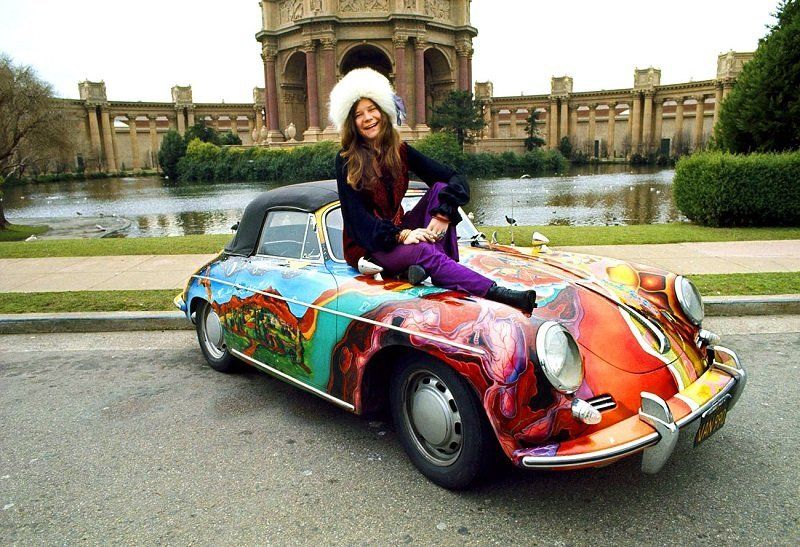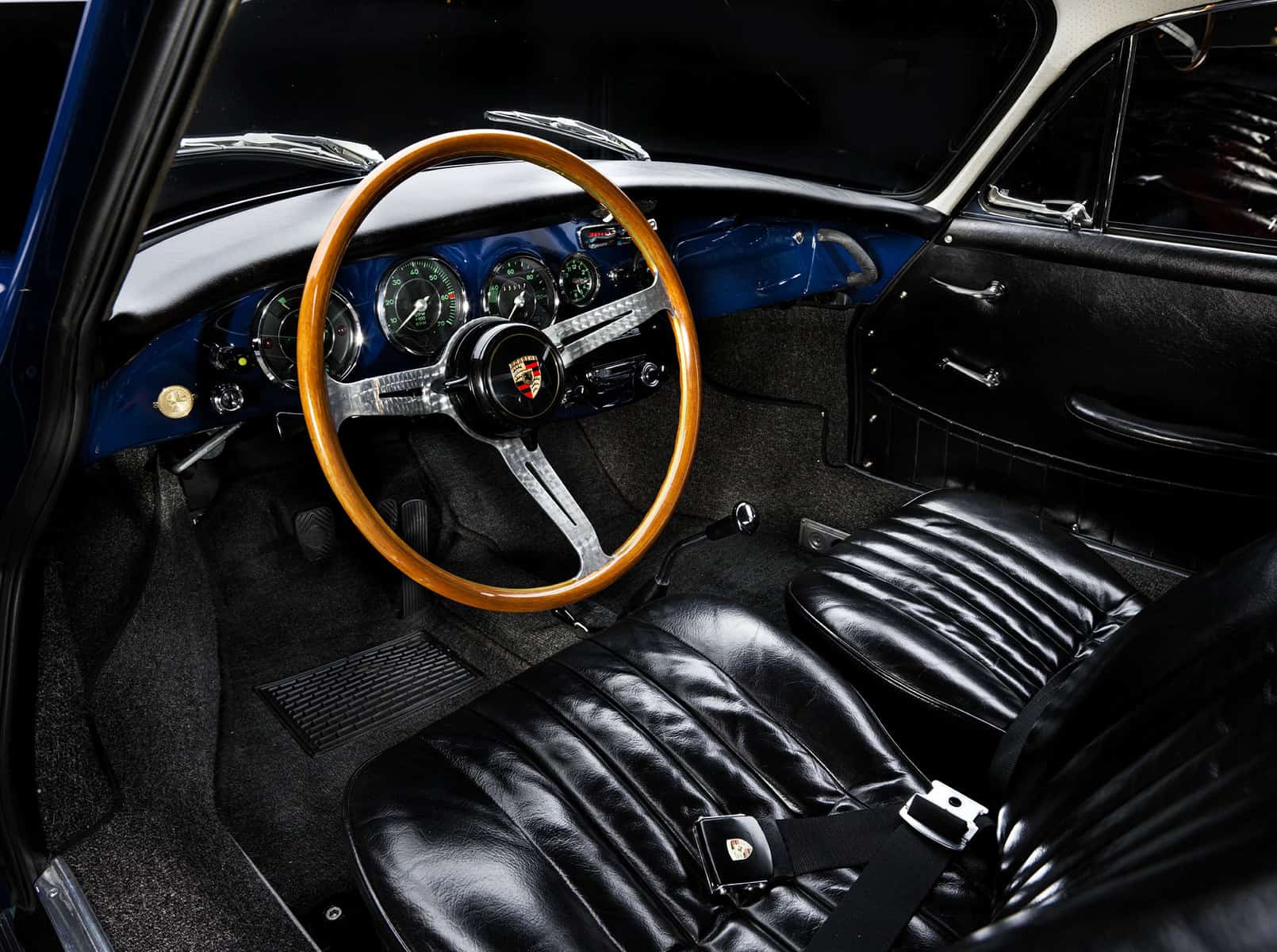The Blue Porsche
A car with a vibrant past, alive in the world today
BY: MILES C. COLLIER
PHOTOS: PETER HARHOLDT, PORSCHE ARCHIVES, GILMORE CAR MUSEUM
I’ve owned my old Bali blue Porsche 356C 1600SC from new, now some fifty-five years. That realization got me thinking about the life that objects lead.
Like humans, that life can last for decades, a century or more, or even can be tragically cut short. The entangled lives such objects lead ranges from manufacture to purchase and use, to wear, repair, restoration, repurposing, modifications, deterioration and, ultimately, ruin. This creates a layered, multitemporal thing with different meanings to different people at different times.

Having owned my Porsche since new, my relationship with it is complex. It was originally a graduation gift from my mother, a handsome one at that, commemorating my completion of secondary school. I used it as a daily driver for four years during college, and then retired it to inactive duty in favor of my Chrysler station wagon whose primary function was towing my E production Porsche Speedster to races. The blue Porsche was the beneficiary of this inactivity as it survived the dangerous years, when it was just a used car, unscathed.
Came the day when, through no change in the car, I saw it through new eyes. No longer was it a mundane car from my past, but instead, the manifestation of not just my past in physical form but the past. Automobiles are so often the place of memories because so much time is spent riding in or driving them. Life-changing things happen in them. Even people who have no interest in cars have car stories: the time the Honda was broken into behind the apartment, the trip to Buffalo for Christmas in a huge snowstorm or being taken to summer camp at age ten. My blue Porsche is laden with those kinds of memories, nothing especially noteworthy perhaps, but they are my memories, nevertheless.

The blue Porsche is an aide memoire. Like dreams, those memories occur randomly in no chronological order. One moment I recall seeing it as my graduation present parked in front of our family home with a large white bow on the roof, in the next, I recall motoring gently at night over snowy back roads in Connecticut, hearing the dull thumping of the engine and the squeak of snow beneath the tires. The heater outlets blew some warm air towards my ankles, but it took the gas-electric auxiliary heater to really warm the cockpit.
My old Porsche transports me back to those long-gone times through its all-encompassing nature as an environment. One minute, I am back in the day, literally sitting inside a vanished present fifty years gone. Through the windshield, I see an incomprehensible future yet to be; and in the next, I am in today’s present, and the blue Porsche is a quaint survivor of a lost past. Time itself becomes plastic, malleable, asynchronous.

But other things happen as well. By driving my car from the past, I re-experience the state of the art fifty years ago. My Porsche’s steering would never be mistaken for that of a modern automobile. I can compare the difference in feel to modern performance car steering and experience the practical effect of today’s engineering, safety, and interior environmental standards. My 356 makes me a better driver because the steering is so light, direct, and utterly precise that driving a modern car feels like driving with boxing gloves. Such contrasts tell us much about the values of the past and those of today: delicate, precise, even leisurely versus smooth, numb, and not so much heavy, because it isn’t, but mechanically complex and systems-oriented.
My car is an active, operating archive of my past. It supplies connections by being the constant that links different times and places. Most significantly, it is the actual object from those times, not a cunningly fabricated simulacrum, gussied up to resemble the car of my youth. This reality represents the highest definition of original and authentic. How would I feel about an identically prepared Porsche sporting all the special features and details of my original car? Clearly, this would not be the same thing. It might be evocative, but it would have no emotional power. This is why some people go in search of a specific old car from their past that represents something valued, lost, but eternally alluring.

I’ve repainted and re-carpeted the Porsche with original materials. Fortunately, that was all it has ever required. By being off the daily driver roster since the 1970s, it avoided the depredations of rust, the single most worrisome aspect of old 356 Porsches. Today, the car is indistinguishable from photographic images taken in the late 1960s. It looks new, drives like new, even smells like new.
I’ve found that the best way to experience my old car is to take it on the occasional four-day, vintage car tour where other old cars are being experienced, re-experienced, revisited by both drivers who knew them in the past and, most importantly, by those who are coming to them for the first time. For those four days, despite periodic disruptions by modern traffic and modern conditions, we old-car drivers inhabit a parallel universe where the referents are all from the past.


As time passes and our world changes, our perceptions of a valued old car are also subject to change. The world is less accommodating of slower, low-power, sporting automobiles in modern, high-speed environments. Use underscores the shortcomings of our “past in the present” automobiles. Modern requirements for reliability, roadability, and yes, even comfort, encourage the minor alterations, redevelopments of these artifacts from the past to make them more suitable as working cars of the past in the present. It is common for owners to see these old cars as, not so much venerated relics of the past that must be preserved forever as they were made, but as the living past in the present, subject to restoration, re-purposing, re-definition through both minor and more major improvements. These changes make these cars more alive in the world of today, for nothing is ever changeless, fixed, or invariable, any more than we are.
In many ways – some definitional in my own mind, some mechanical and physical – my old 356 Porsche is a bit of active matter from a vibrant past, alive in the world today. That life is defined by change, the characteristic of all life. My old car and I will be continuing a journey of change. It will be informed by the past but mediated by new experiences, new needs, and new realities.





